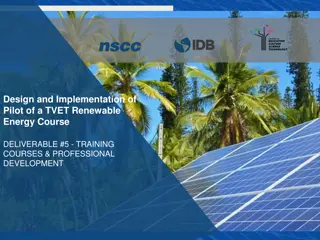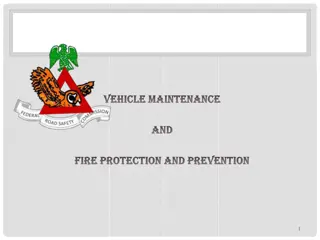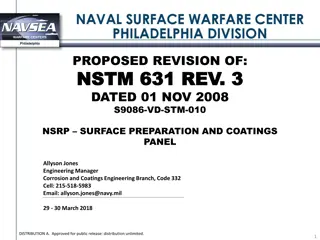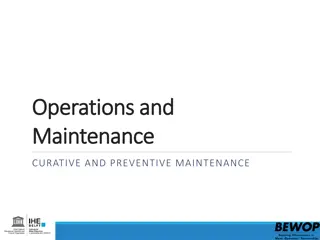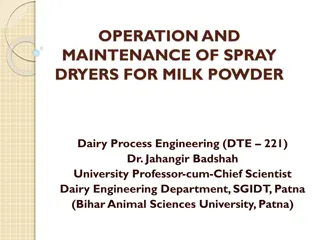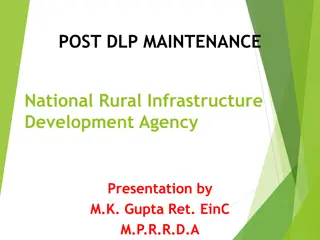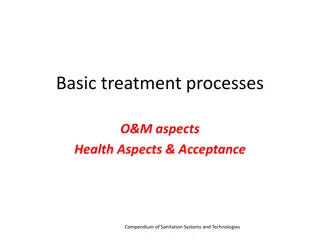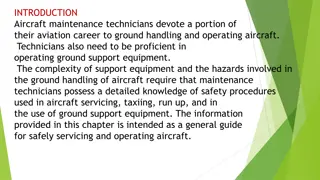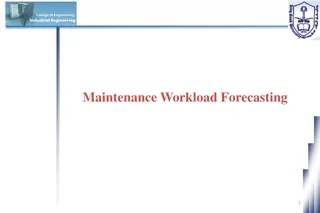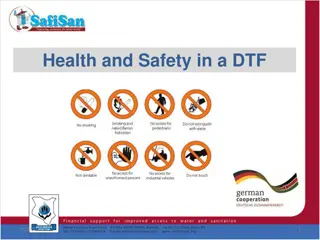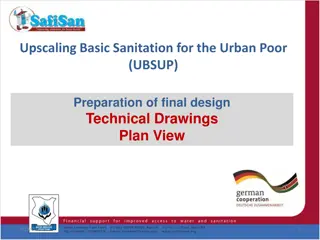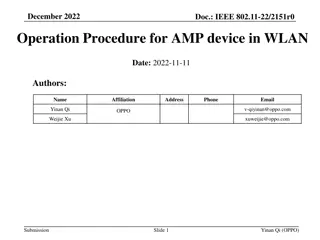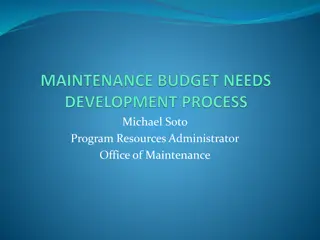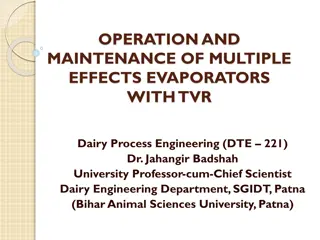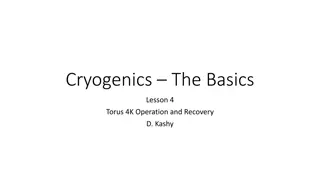Operation and Maintenance Procedures for a DTF System
These detailed O&M procedures outline the necessary steps for maintaining different components of a DTF system, including the Receiving Bay, Balancing Tank, Settler, Anaerobic Baffled Reactor, and Vertical Flow Constructed Wetland. The tasks range from inspecting chambers for blockages, removing floating materials, monitoring sludge levels, to ensuring proper drainage and biomass activity. By following these procedures diligently, the system can operate efficiently and effectively.
Download Presentation

Please find below an Image/Link to download the presentation.
The content on the website is provided AS IS for your information and personal use only. It may not be sold, licensed, or shared on other websites without obtaining consent from the author. Download presentation by click this link. If you encounter any issues during the download, it is possible that the publisher has removed the file from their server.
E N D
Presentation Transcript
Operation and Maintenance in a DTF 9/19/2024 1
O&M procedures Receiving Bay Rake the solid waste from the two screens after each exhauster offload Spread the solid waste on top of the drying platform until it is completely dry before collecting it into the solid waste chamber. Remove regularly (incineration or disposal) the solid waste from the chamber. Clean the receiving bay daily with water to avoid odours and remove silt and sludge residue. Cover systematically the openings of the receiving bay at night and during day time when it is raining to prevent rain water to enter the system 9/19/2024 2
O&M procedures Balancing Tank Inspect the outlet chamber daily: to check for any blockages to control the valve opening Inspect and remove weekly the floating material that might have gone through the screens. Remove the grit and settled sludge when it has accumulated (> 5 cm). Removal can be done manually (with a spade) or mechanically (with a sludge pump or vacuum truck). Before entering the tank, ensure it is empty and leave the manholes open for at least 24h. 9/19/2024 3
O&M procedures Settler Inspect the inlet and outlet chamber daily to check for any blockages Inspect and remove weekly the floating material from both tanks Inspect monthly the level of sludge and scum in both tanks. Remove the scum when the layer has reached a thickness of 5 cm. Remove the sludge when the layer has reached a thickness of 60 cm. Leave a minimum of 10 cm layer of sludge to ensure active biomass 9/19/2024 4
O&M procedures Anaerobic Baffled Reactor Inspect the inlet, outlet and distribution chambers daily to check for any blockages Inspect and remove weekly the floating material from each chamber Inspect monthly the level of sludge and scum in each chamber tank. Remove the scum when the layer has reached a thickness of 5 cm. Remove the sludge when the layer has reached a thickness of 100 cm. Leave a minimum of 30 cm (50 cm in the first 4 chambers) layer of sludge to ensure active biomass Remove regularly the sludge from the siphon chamber 9/19/2024 5
O&M procedures Vertical Flow Constructed Wetland Daily visual check on the basins: flow evenly distributed no saturation moderate reeds growth stability of the embankments Inspect weekly the central drainage channel: no leakages in the basins flow is evenly drained no filter media being washed out Inspect weekly the condition of the ball cock valves and the saddle clamps in the distribution chamber (no leakage) 9/19/2024 6
O&M procedures Vertical Flow Constructed Wetland (follow-up) Interchange the use of each wetland every 2 weeks by using and closing the valves in the distribution chamber. Remove regularly the weeds and other plants that might interfere with reeds growth. Remove the plant litter when it covers entirely the surface of the wetland. Harvest the reeds when necessary (when vegetation becomes too dense). Replace or back-wash the filter media when it is clogged or when efficiency is reduced. The back-washing is done by spreading the filter media on the ground outside the wetland and wash it with a power hose. 9/19/2024 7
O&M procedures Sludge Drying Beds Ensure that before allowing discharge of an exhauster, the sludge level should allow a minimum of 20 cm freeboard Daily visual check on the beds proper drainage remove and dispose of the solid waste remove weeds, roots, leaves Inspect monthly the outlet chamber of each bed: no clogging in the drainage pipe no filter media being washed out Top-up the sand layer after 10-20 drying sequences Replace or back-wash the filter media when necessary 9/19/2024 8
O&M procedures Composting shed For co-composting related activities, refer to the operating and maintaining a co-composting facility manual Inspect monthly the roof and gutter of the shed: Clear the gutter when necessary Clean the translucent PVC roof sheets to allow light in Check for breakages in the roof sheets or in the gutter and do the necessary repairs Ensure that the platform is clean and that the drainage channel is clear Ensure that there is no clogging at the soak pit level Empty the rain water harvesting cistern regularly (after each rain event) 9/19/2024 9
O&M procedures Overall DTF Check on the structural condition of each treatment module: cracks, settlement of structure, caving of the suspended slab, etc. Control the corrosion on the metal parts: scrap rust, paint metal surfaces, repair corroded concrete reinforcement. Inspect the soil moisture condition around the modules to identify any leakages from the pipes or from the modules themselves. Clean the external walls and slab of the module once or twice per year either with a power hose or with a brush and some water. Control the vegetation: regular grass cutting, weeding, trimming of trees, watering of plants (when applicable), removal of plants and roots around the modules. Swipe the concrete surface: modules suspended slab and platforms. Keep the Operator Store clean and tidy. 9/19/2024 10
Proposed list of equipment High pressure washer Cover lifter Ladder Rake Spade or shovel Skimmer Slasher or Scissor Panga Water bucket Stiff broom Wheelbarrow Mop 9/19/2024 11



